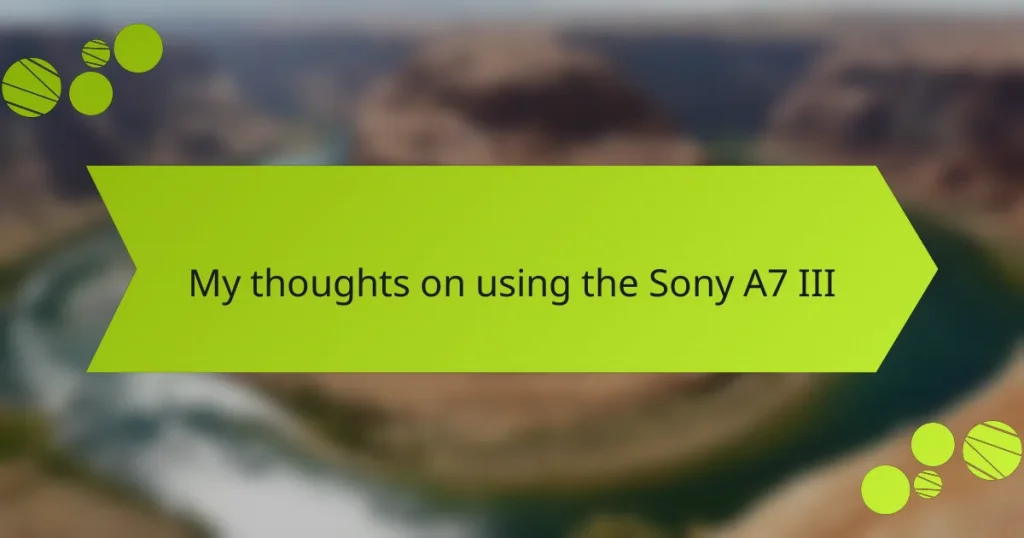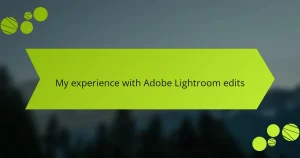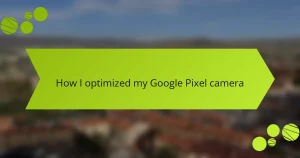Key takeaways
- The Sony A7 III features a 24.2 MP full-frame sensor and a fast hybrid autofocus system with 693 points, making it suitable for various shooting conditions.
- Impressive low-light performance with minimal noise, alongside excellent battery life, allows for extended shooting without interruptions.
- Versatile shooting modes and ergonomic design enhance user experience, catering to both hobbyists and professionals alike.
- Utilizing quality lenses and post-processing software like Adobe Lightroom can significantly improve photography results with the A7 III.
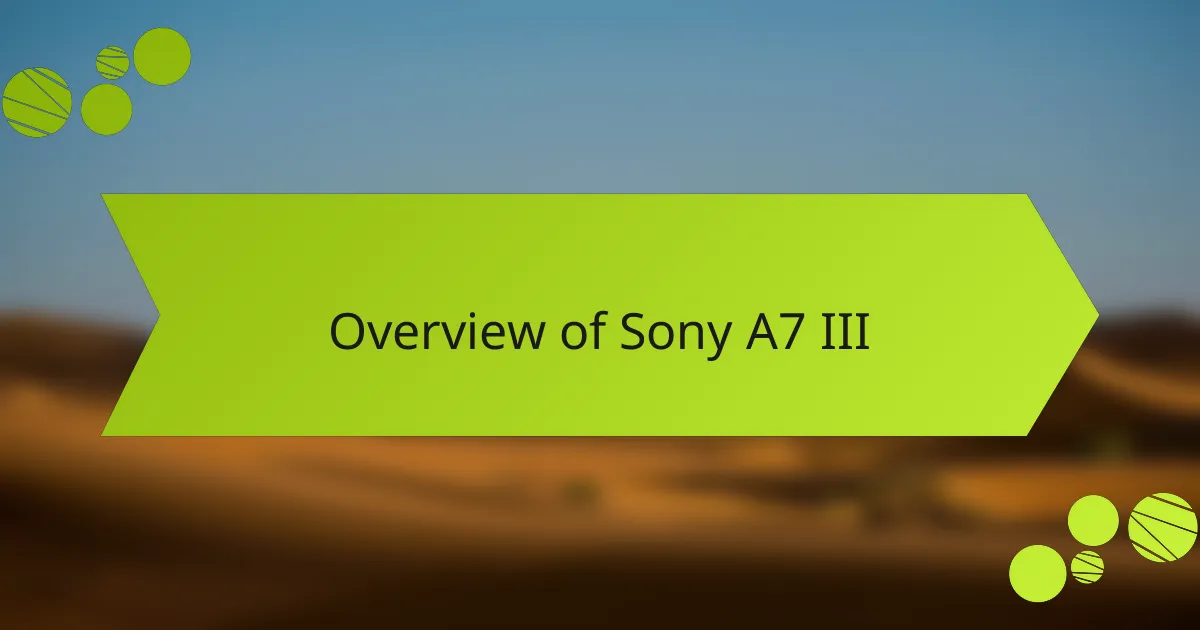
Overview of Sony A7 III
The Sony A7 III is a powerhouse in the realm of mirrorless cameras, combining impressive performance with user-friendly features. From my experience, it strikes a remarkable balance between functionality and portability, making it a perfect companion for both seasoned photographers and enthusiastic hobbyists. I’ve taken this camera on various adventures, and its ability to capture stunning low-light images while maintaining sharp details continues to amaze me.
What I appreciate most about the A7 III is its versatility. Whether I’m shooting landscapes during golden hour or candid moments at a family gathering, this camera adapts effortlessly to any situation. Here are some of its standout features:
- Full-frame 24.2MP Exmor R CMOS sensor for exceptional image quality
- Fast Hybrid AF system with 693 phase-detection points for quick and precise focusing
- 10 frames per second continuous shooting for action shots
- Excellent battery life allowing for extended shooting sessions
- Dual card slots for increased storage options and backup reliability
I can’t stress enough how these features transformed my photography. Having the A7 III in my hands feels like having a reliable partner on every shoot.
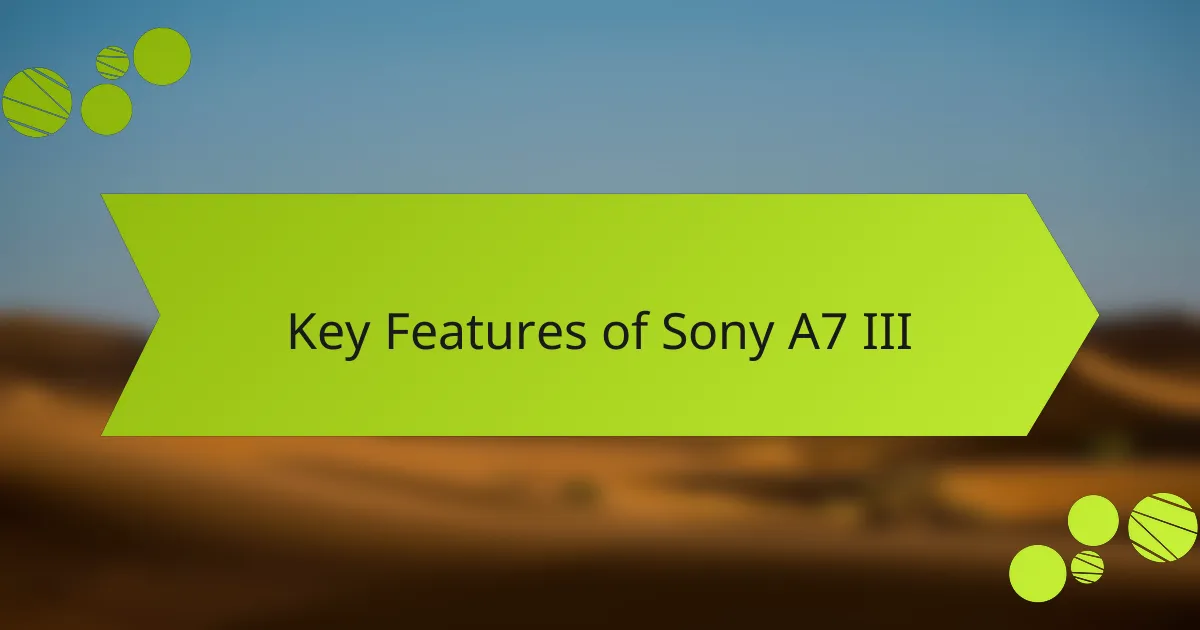
Key Features of Sony A7 III
The Sony A7 III truly stands out with its impressive 24.2 MP full-frame sensor, which captures stunning detail and vibrant colors. I remember taking it out for a day of landscape photography, and I was blown away by how well it handled low-light situations. The dynamic range is remarkable, allowing shadows and highlights to co-exist beautifully in a single frame.
Another feature I love is the 693-point fast hybrid autofocus system — it’s like having a personal assistant that never misses a shot. I recall a moment when I was photographing my kids at a park; the camera locked onto them instantly, and I was able to capture their joyful expressions without a hitch. Plus, the 10 fps continuous shooting mode makes it easy to capture those fleeting moments, which as a parent, I cherish.
The A7 III’s in-body image stabilization is something I can’t overlook either. It helped me shoot at slower shutter speeds without the fear of blurry images, which was particularly useful during a recent evening shoot at a bustling market. This feature, coupled with its impressive battery life, makes it a reliable companion for any photographer, whether you’re shooting portraits or breathtaking landscapes.
| Feature | Description |
|---|---|
| Sensor | 24.2 MP full-frame sensor |
| Autofocus | 693-point hybrid autofocus system |
| Continuous Shooting | 10 fps |
| Image Stabilization | In-body 5-axis stabilization |
| Battery Life | Approximately 710 shots per charge |
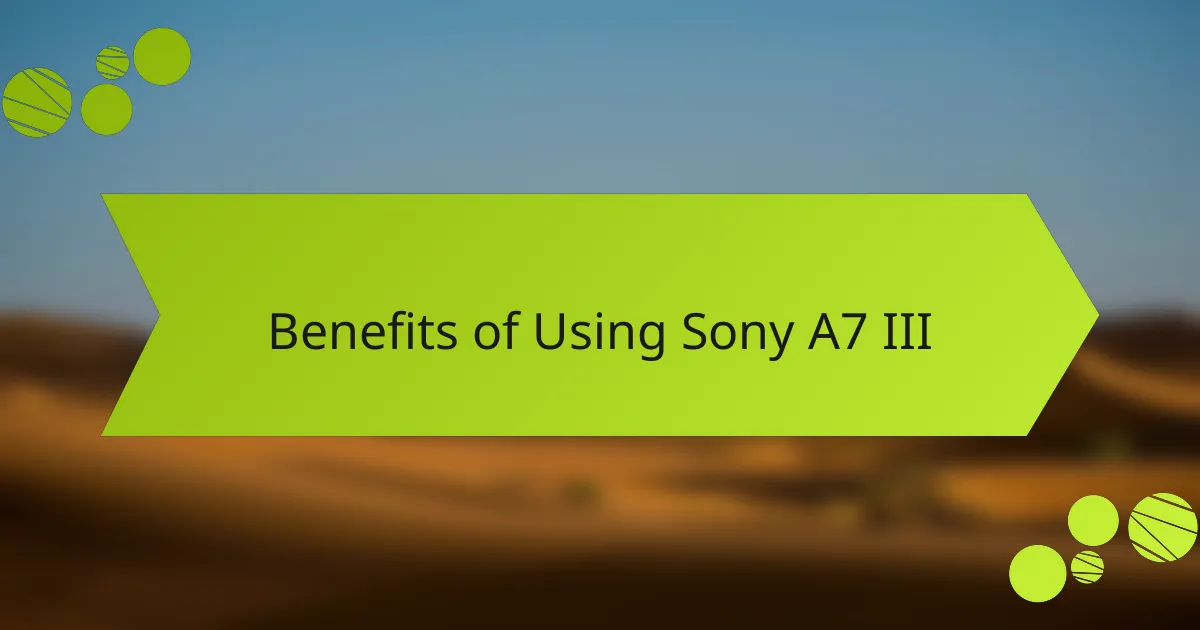
Benefits of Using Sony A7 III
When I first picked up the Sony A7 III, I was impressed by its ability to excel in various shooting conditions. The camera’s low-light performance blew me away during an evening event I shot; it delivered crisp images with minimal noise. This versatility makes it a fantastic choice for both hobbyists and professionals looking to capture stunning shots without worrying about lighting.
Another thing I appreciate is the A7 III’s autofocus system. It’s incredibly fast and reliable, making it easy to catch those fleeting moments, like a child’s spontaneous laugh. This feature has greatly improved my workflow, allowing me to focus more on creativity rather than adjusting settings constantly.
The battery life is another surprising benefit. I’ve shot an entire day’s worth of events without needing a recharge, which reduces my anxiety about missing out on key moments. Overall, these features combine to make the Sony A7 III a powerful tool in any photographer’s arsenal.
| Feature | Benefit |
|---|---|
| Low-Light Performance | Minimal noise in low lighting conditions |
| Fast Autofocus | Easy to capture quick moments with precision |
| Battery Life | Long-lasting, reducing worry during shoots |
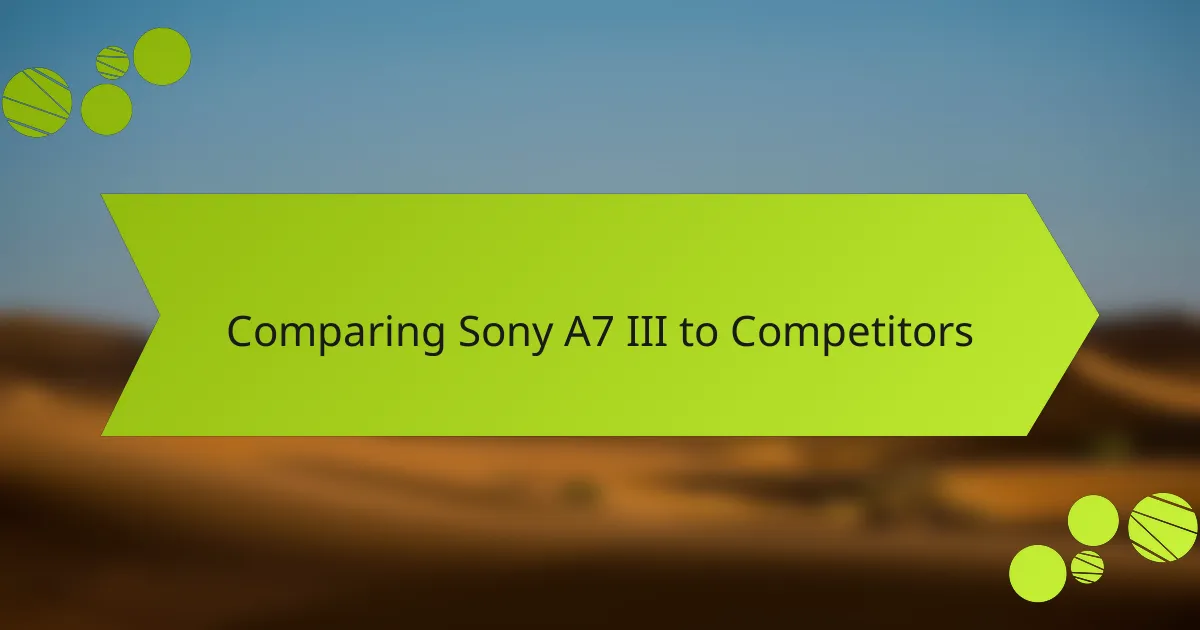
Comparing Sony A7 III to Competitors
When I first held the Sony A7 III, I was immediately struck by its balance and weight. Compared to its competitors, like the Canon EOS R and Nikon Z6, I found that the A7 III offered superior autofocus performance, which made capturing fast-moving subjects a breeze. For someone who often shoots wildlife, this feature was particularly invaluable, allowing me to focus on the moment rather than worrying about lag in focus.
The A7 III stands out not just in autofocus but also in battery life, making it a reliable choice for long shooting sessions. Here’s how it stacks up against some of its main rivals:
- Battery Life: A7 III lasts approximately 710 shots, while EOS R offers around 370 shots and Nikon Z6 about 330 shots.
- Autofocus Points: A7 III boasts 693 phase-detection points compared to the EOS R’s 565 and Z6’s 273.
- Image Stabilization: A7 III features 5-axis in-body stabilization, offering an edge over the Z6’s similar system, while the EOS R lacks this feature entirely.
- Price Point: A7 III is often priced more competitively than its counterparts, providing excellent value for its features.
Overall, the performance aspects of the A7 III have solidified my choice as a top contender in the mirrorless market.
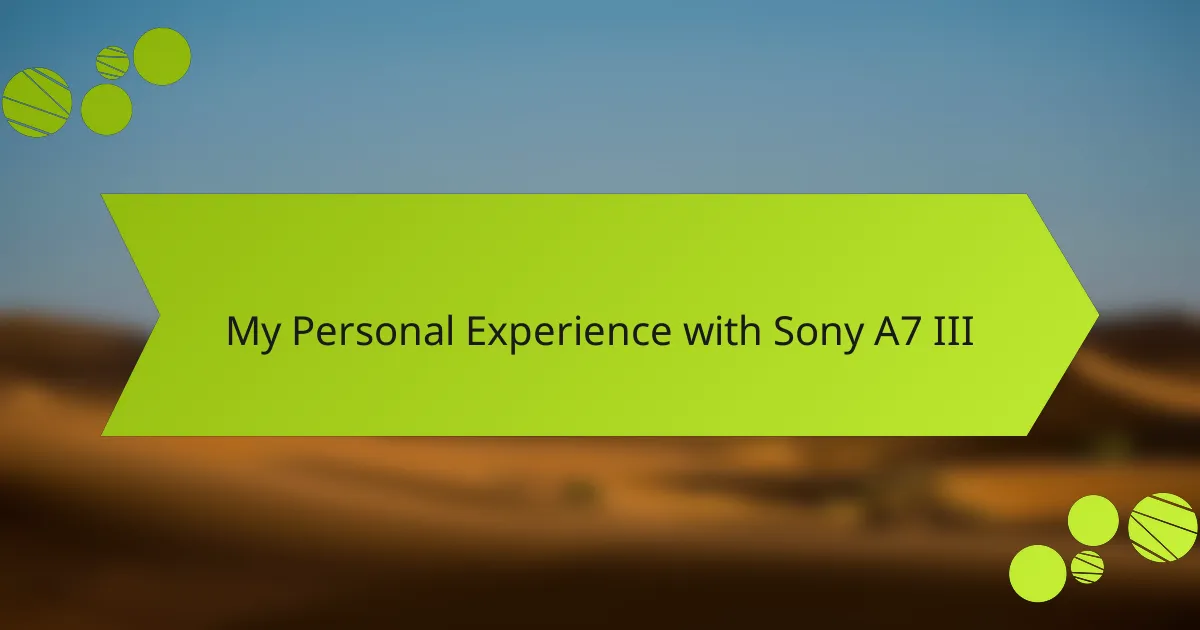
My Personal Experience with Sony A7 III
The moment I first held the Sony A7 III, I was struck by its blend of sophistication and user-friendliness. It felt like an extension of my creative instincts, making it easy to capture stunning images in various lighting conditions. I remember a late afternoon at the park when the golden light was just perfect; the camera delivered vibrant colors that truly reflected the scene’s beauty.
From my experience, here are some key highlights of using the Sony A7 III:
- Incredible Low-Light Performance: I’ve taken shots in dimly lit environments and was amazed at how little noise appeared in the images.
- Fast Autofocus: The autofocus system has saved me more times than I can count, especially during fast-paced events.
- Versatile Shooting Modes: Whether I’m in the mood for a portrait or a landscape, the various modes cater to my needs seamlessly.
- Ergonomic Design: I’ve spent hours shooting without feeling fatigued, thanks to its comfortable grip and well-placed controls.
- Battery Life: The extended battery life has been a game-changer during long days of shooting, allowing me to focus on capturing moments rather than switching batteries.
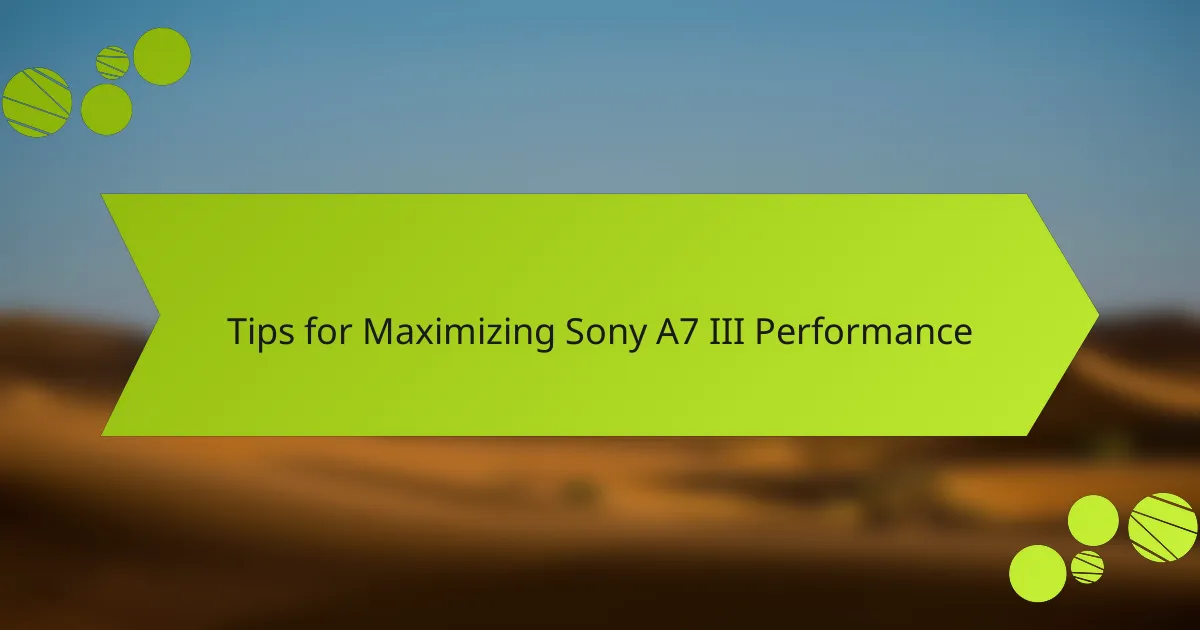
Tips for Maximizing Sony A7 III Performance
When it comes to maximizing the performance of the Sony A7 III, I believe in a few key practices that can really enhance your photography experience. First, take some time to understand the camera’s settings and features. For instance, learning how to adjust the autofocus modes can help you capture fast-moving subjects with clarity, which I found invaluable during a recent event I shot.
Additionally, using the right lenses can significantly impact your results. I always recommend investing in a versatile lens like the 24-70mm f/2.8 for most scenarios. This lens performed brilliantly for me during a wedding shoot, allowing me to capture both wide shots and close-ups seamlessly.
Finally, don’t forget about the importance of post-processing. Experimenting with software like Adobe Lightroom can dramatically elevate the quality of your photos, as it was for me when I edited some of my shots after a recent trip.
| Tip | Description |
|---|---|
| Understand Settings | Familiarize yourself with autofocus modes for better action shots. |
| Use Versatile Lenses | Invest in quality lenses, like the 24-70mm f/2.8, for flexibility. |
| Post-Processing | Leverage software like Lightroom to enhance your images. |
